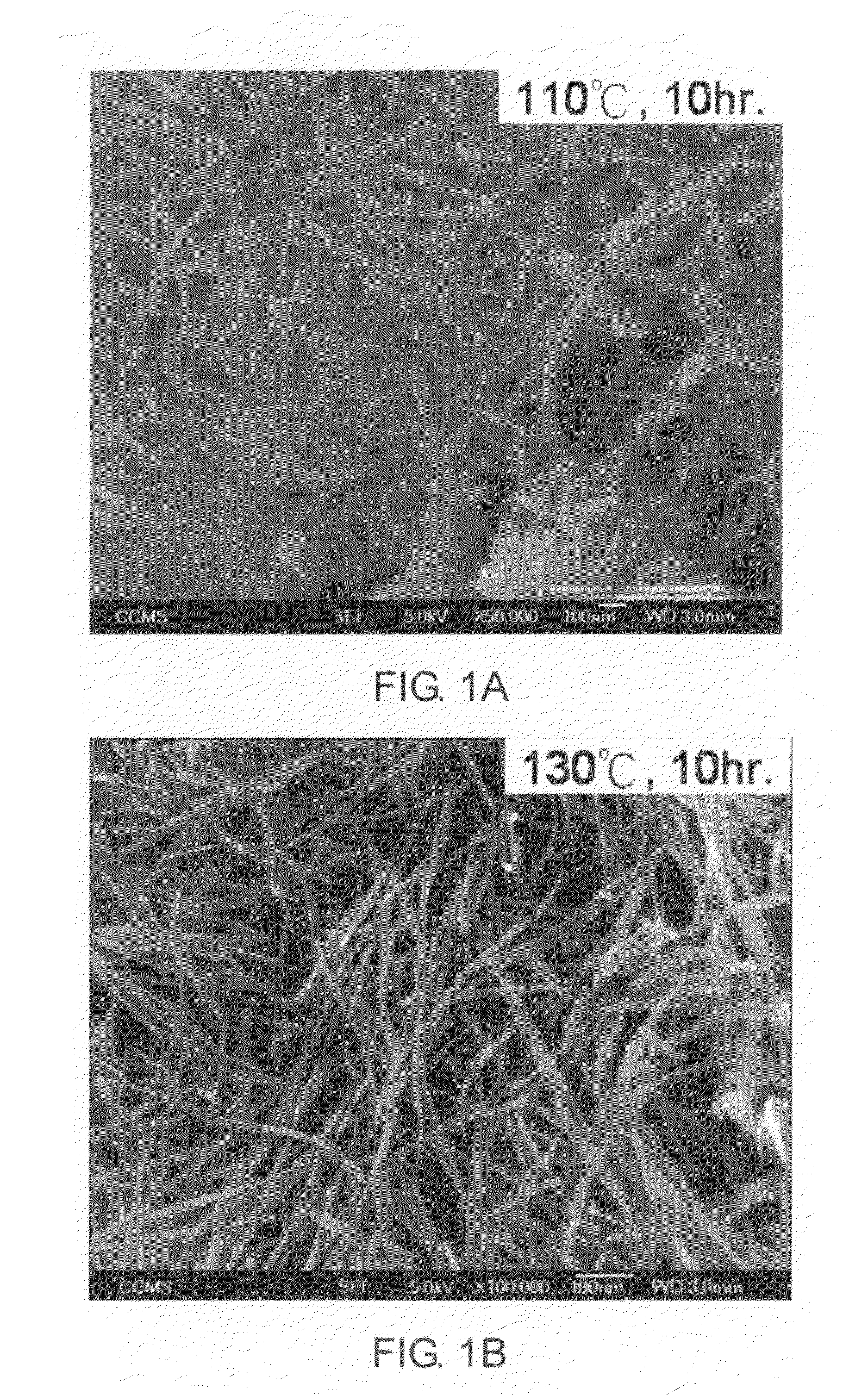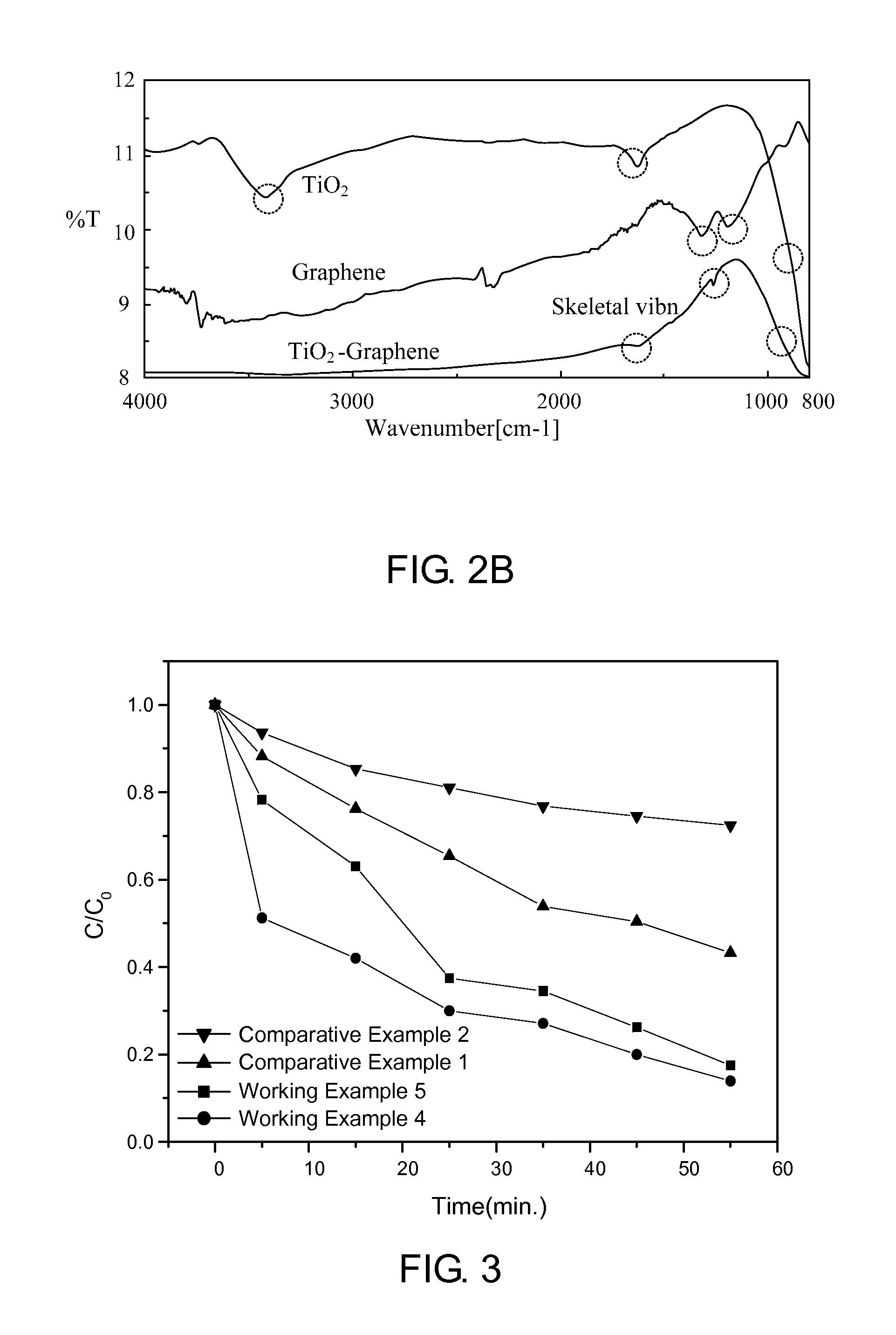Graphene/nano-titanium dioxide composites and methods for preparing the same
a graphene and nanotitanium dioxide technology, applied in the field of graphene/nanotitanium dioxide composites and methods for preparing the same, can solve the problems of unsatisfactory photocatalytic efficiency of such photocatalytic catalysts, pose a threat to ecology and human health, etc., and achieve better photocatalytic degradation rate and high specific surface area
- Summary
- Abstract
- Description
- Claims
- Application Information
AI Technical Summary
Benefits of technology
Problems solved by technology
Method used
Image
Examples
experiment i
[0050]In experiment I, titanium dioxide nanotubes were prepared in accordance with the hydrothermal processing method according to embodiments of the present invention with various reaction temperatures and retained times. Also, the morphologies and specific surface areas of these titanium dioxide nanotubes were investigated. The reaction temperature and retained time used in each working example, and the specific surface area of the as-produced titanium dioxide nanotubes are summarized in Table 1.
TABLE 1WorkingReactionRetained TimeSpecific SurfaceExampleTemperature (° C.)(hours)Area (m2 / g)1-11105203.31-211010374.51-311020376.12-11305355.32-213010403.12-313020374.13-11505312.43-215010376.23-315020279.2
[0051]As can be seen in Table 1, when the retained time is the same, the specific surface areas of the resultant titanium dioxide nanotubes would first increase and then decrease as the reaction temperature increases. Besides, when the reaction temperature is the same, the specific sur...
experiment ii
[0053]In this experiment, the titanium dioxide nanotubes of the working example 1-2 were used to prepare the graphene / nano-titanium dioxide composites of working example 4 in accordance with the preparation method provided hereinabove.
[0054]More specifically, about 3 micrograms of graphenes were soaked in about 1 M sulfuric acid for about 10 hours, so that at least a portion of the surfaces of the graphenes were oxidized to obtain oxidized graphene. Then, about 3 grams of titanium dioxide nanotubes and said oxidized graphenes were added into a water / ethanol (volume ratio about 2.5:1) to obtain a dispersion.
[0055]The dispersion then was subjected into an autoclave and the reaction was allowed to proceed at a pressure of about 12 MPa and a temperature of about 110° C. for about 6 hours. After the compounding reaction, the products were rinsed with de-ionized water and filtered for several times, and the washed products were than dried in a vacuum oven at about 40° C.
[0056]FIG. 2A is a...
experiment iii
[0058]In this experiment, various graphene / nano-titanium dioxide composites were prepared in accordance with the method described hereinabove, and the photocatalytic degradation efficiencies of these materials were analyzed with the non-compounded nano-titanium dioxides as reference. Test results are summarized in Table 2 and FIG. 3.
TABLE 2MorphologyC / C0 after 55 minutesWorkingGraphene / Titanium dioxide13.89%Example 4nanotube compositesWorkingGraphene / Titanium dioxide17.46%Example 5nanoparticle compositesComparativeTitanium dioxide nanotubes43.25%Example 1(from working example 1-2)ComparativeCommercial titanium dioxide72.40%Example 2nanoparticles
[0059]In this experiment, the titanium dioxide nanotubes of the working example 1-2 were used in the comparative example 1, whereas the commercial DEGUSSA P-25 titanium dioxide nanoparticles were used in the comparative example 2. The graphene / nano-titanium dioxide composites prepared in the Experiment II hereinabove were used in working exam...
PUM
| Property | Measurement | Unit |
|---|---|---|
| volume ratio | aaaaa | aaaaa |
| temperature | aaaaa | aaaaa |
| pressure | aaaaa | aaaaa |
Abstract
Description
Claims
Application Information
 Login to View More
Login to View More - R&D
- Intellectual Property
- Life Sciences
- Materials
- Tech Scout
- Unparalleled Data Quality
- Higher Quality Content
- 60% Fewer Hallucinations
Browse by: Latest US Patents, China's latest patents, Technical Efficacy Thesaurus, Application Domain, Technology Topic, Popular Technical Reports.
© 2025 PatSnap. All rights reserved.Legal|Privacy policy|Modern Slavery Act Transparency Statement|Sitemap|About US| Contact US: help@patsnap.com



